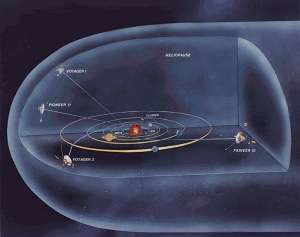Voyager 1 on Verge of Exiting Solar System, At Least 15,000 Years Away

Big news in the world of fancy objects hurtling across vast distances in space, via Phys.Org:
"The latest data from Voyager 1 indicate that we are clearly in a new region where things are changing quickly," says Ed Stone, Voyager project scientist at the California Institute of Technology in Pasadena. This is very exciting. We are approaching the solar system's final frontier."
The "frontier" he's referring to is the edge of the heliosphere, a great magnetic bubble that surrounds the sun and planets. The heliosphere is the sun's own magnetic field inflated to gargantuan proportions by the solar wind. Inside lies the solar system—"home." Outside lies interstellar space, where no spacecraft has gone before…
"From January 2009 to January 2012, there had been a gradual increase of about 25 percent in the amount of galactic cosmic rays Voyager was encountering," says Stone.
"More recently, however, we have seen a very rapid escalation in that part of the energy spectrum. Beginning on May 7, 2012, the cosmic ray hits have increased five percent in a week and nine percent in a month."
The sharp increase means that Voyager 1 could be on the verge of a breakthrough 18 billion kilometers from Earth.
When Voyager 1 actually exits the heliosphere, researchers expect to see other changes as well. For one thing, energetic particles from the sun will become scarce as the spacecraft leaves the heliosphere behind. Also, the magnetic field around Voyager 1 will change direction from that of the sun's magnetic field to that of the new and unexplored magnetism of interstellar space.
So far, neither of these things has happened. Nevertheless, the sudden increase in cosmic rays suggests it might not be long.
Though Voyager 1 is about to cross the heliopause, it's not out of the woods yet. From NASA:
In that sense, it can be said that [after crossing the heliopause] the spacecraft will be able to sample what space is like beyond our solar system. (If we define the solar system as the Sun and everything that primarily orbits the Sun, however, Voyager 1 will remain within the confines of the solar system until it emerges from the Oort cloud in another 14,000 to 28,000 years).
Voyager 1 is not expected to last so long. Voyager 2 isn't far behind, and of course a private craft may eventually outpace them.
Reason's February 2012 space issue
